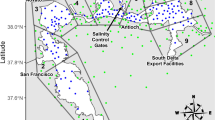Abstract
The design of environmental monitoring programs is frequently hampered by a lack of objective, quantitative criteria for evaluating alternative monitoring variables. In this paper we describe two such criteria, which we call samples required — the number of samples required to detect a given change in value — and information imparted — the amount of environmental information revealed by the monitoring variable. We then use these criteria to evaluate fin erosion in winter flounder (Pleuronectes americanus) and Dover sole (Microstomus pacificus) as marine environmental monitoring variables. Two methods for determining the samples required use contaminated and reference areas to estimate the sample statistics of a hypothetical impacted population. The first method is based on the overall difference in the proportions of diseased fish in the reference and hypothetical populations. The second treats the proportion of diseased fish in individual trawls as the variate and determines the samples required based on the mean and variance of the reference and contaminated populations. We use both methods to predict the number of trawls needed to detect an increase of 200% in fin erosion in the reference population. The first method had greater statistical power but assumes spatially homogeneous populations. The second method accounts for environmental patchiness. For Dover sole it predicted 1661 trawls would be needed to detect the 200% increase. An estuarine winter flounder population would require 74 trawls, and an oceanic winter flounder population would require 142.5 trawls. It appears that fin erosion in winter flounder may be a useful indicator of environmental contamination, but several stipulations apply. Migration may inflate the number of diseased fish observed in the reference population, and a more detailed etiology of the disease is required, including an understanding of what contaminants are responsible for manifestation of the disease.
Similar content being viewed by others
References
Beardsley, R.C. and Butnam, B.: 1974, ‘Circulation on the New England Continental Shelf: Response to Strong Winter Storms’, Geophys. Res. Letters 1, 181–184.
Bumpus, D.F.: 1965, ‘Residual Drift Along the Bottom on the Continental Shelf in the Middle Atlantic Bight Area’, Limnol. Oceanogr. 10, R50-R53.
Boehm, P.: 1982, ‘Organic Contaminants (PCB's, Polynuclear Aromatic Hydrocarbons and Coprostanol) in Sediments. Contaminants in New York Bight and Long Island Sound Sediments and Demersal Species, and Contaminant Effects on Benthos, Summer 1980’, NOAA Tech. Mem., NMFS-F/NEC-16.
Cross, J.N.: 1984, ‘Fin Erosion Among Fishes Collected Near a Southern California Municipal Wastewater Outfall (1971–1982)’, Coastal Water Research Project Biennial Report 1983–1984, W. Bascom (ed.), SCCWRP, Long Beach, California.
Davis, H.S.: 1953, Culture and Diseases of Game Fishes, University of California Press, Berkeley and Los Angeles.
Dixon, W.J. and Massey, F.J.: 1983, Introduction to Statistical Analysis, McGraw-Hill, New York.
Hagerman, F.B.: 1952, The Biology of the Dover Sole, Microstomus pacificus (Lockington), State of California Dept. Fish Game. Bull. 85, 48 pp.
Hendricks, T.J.: 1980, ‘Currents in the Los Angeles Area’, Coastal Water Research Project Biennial Report 1979–1980, W. Bascom (ed.), SCCWRP, Long Beach California.
Jacquez, G.M. and Rohlf, F.J.: 1986, ‘Problems in the Variance Analysis of Nine Environmental Monitoring Variables: Determining the Number of Samples Needed to Detect a Change in Mean of 50%’, Oceans '86 Conference Record 3, 974–979.
Levin, M.A., Wolke, R.E., and Cabelli, J.V.: 1972, ‘Vibrio anguillarum as a Cause of Disease in Winter Flounder (Pleuronectes americanus)’, Can. J. Microbiol. 18, 1585–1592.
Lobell, M.J.: 1939, ‘A Biological Survey of the Salt Waters of Long Island, 1938. Report on Certain Fishes. Winter Flounder (Pleuronectes americanus)’, Suppl. to 28th Annual Rept. N.Y. State Conserv. Dept., Pt. I, 63–96.
Mahoney, J.B., Midlige, F.H., and Devel, D.G.: 1973, ‘A Fin Rot Disease of Marine and Euryhaline Fishes in the New York Bight’, Trans. Amer. Fish. Soc. 102, 596–605.
McCracken, F.D.: 1963, ‘Seasonal Movements of the Winter Flounder Pleuronectes americanus (Walbaum), on the Atlantic Coast’, J. Fish. Res. Bd. Canada 20, 551–586.
Mearns, A.J. and Sherwood, M.: 1974, ‘Environmental Aspects of Fin Erosion and Tumors in Southern California Dover Sole’, Trans. Amer. Fish. Soc. 4, 799–810.
MESA: 1975, ‘Ocean Dumping in the New York Bight’, NOAA Technical Report ERL 321-MESA, 2.78 pp.
Oppenheimer, C. and Kesteven, G.L.: 1958, ‘A Bacterium Causing Tail Rot in the Norweigan Codfish’, Publ. Inst. Mar. Sci. Univ. Texas 5, 160–164.
Robohm, R.A., Brown, C., and Murchelano, R.A.: 1979, ‘Comparison of Antibodies in Marine Fish from Clean and Polluted Waters of the New York Bight: Relative Levels against 36 Bacteria’, App. Env. Microbiol. 38, 248–257.
Rohlf, F.J.: 1985, BIOM A Package of Statistical Programs to Accompany the Text Biometry. Copyright (C) 1982, 1983, 1984, 1985 by F. James Rohlf.
Sherwood, M.J. and Mearns, A.J.: 1977, ‘Environmental Significance of Fin Erosion in Southern California Demersal Fishes’, Ann. N. Y. Acad. Sci. 298, 177–188.
Sokal, R.R. and Rohlf, F.J.: 1981, Biometry, W.H. Freeman and Company, San Francisco, California, 859 pp.
Wellings, S.R., Alpers, C.E., McCain, B.B., and Miller, B.S.: 1976, ‘Fin Erosion Disease of Starry Flounder (Platichthys stellatus) and English Sole (Parophyrs vetulus) in the Estuary of the Duwamish River, Seattle, Washington’, J. Fish. Res. Board Can. 33, 2577–2586.
Word, J.Q. and Mearns, A.J.: 1978, ‘The 60-meter Control Survey’, Coastal Water Research Project Annual Report for the year 1978, W. Bascom (ed.), SCWRRP, Long Beach California, pp. 41–56.
Young, D.R., Jan, T.K., and Heesen, T.C.: 1978, ‘Cycling of Trace Metal and Chlorinated Hydrocarbon Wastes in the Southern California Bight’, Estuarine Interactions, M.L. Wiley (ed.), Academic Press, New York.
Ziskowski, J. and Murchelano, R.: 1975, ‘Fin Erosion in Winter Flounder’, Mar. Pollut. Bull. 6, 26–29.
Ziskowski, J., Despres-Patanjo, L., Murchelano, R.A., Howe, A.B., Ralph, D., and Atran, S.: 1987, ‘Disease in Commercially Valuable Fish Stocks in the Northwest Atlantic’, Mar. Pollut. Bull. 9, 496–504.
Author information
Authors and Affiliations
Rights and permissions
About this article
Cite this article
Jacquez, G.M., Ziskowski, J. & Rohlf, F.J. Criteria for the evaluation of alternative environmental monitoring variables: Theory and an application using winter flounder (Pleuronectes americanus) and Dover sole (Microstomus pacificus). Environ Monit Assess 30, 275–290 (1994). https://doi.org/10.1007/BF00546204
Revised:
Issue Date:
DOI: https://doi.org/10.1007/BF00546204




